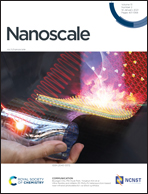IFPTML mapping of nanoparticle antibacterial activity vs. pathogen metabolic networks†
Abstract
Nanoparticles are useful antimicrobial drug-release systems, but some nanoparticles also exhibit antibacterial activity. However, investigation of their antibacterial activity is a difficult and slow process due to the numerous combinations of nanoparticle size, shape, and composition vs. biological tests, assay organisms, and multiple activity parameters to be measured. Additionally, the overuse of antibiotics has led to the emergence of resistant bacterial strains with different metabolic networks. Computational models may speed up this process, but the models reported to date do not to consider all the previous factors, and the data sources are dispersed and not curated. Thus, herein, we used an information fusion, perturbation-theory machine learning (IFPTML) approach, which is introduced by us for the first time, to fit a model for the discovery of antibacterial nanoparticles. The dataset studied had 15 classes of nanoparticles (1–100 nm) with most cases in the range of 1–50 nm vs. >20 pathogenic bacteria species with different metabolic networks. The nanoparticles studied included metal nanoparticles of Au, Ag, and Cu; oxide nanoparticles of Zn, Cu, La, Al, Fe, Sn, Ti, Cd, and Si; and metal salt nanoparticles of CuI and CdS. We used the SOFT.PTML software (our own application) with a user-friendly interface for the IFPTML calculations and a control statistics package. Using SOFT.PTML, we found a linear logistic regression equation that could model 4 biological activity parameters using only 8 variables with χ2 = 2265.75, p-level <0.05, sensitivity, Sn = 79.4, and specificity, Sp = 99.3, for 3213 cases (nanoparticle-bacteria pairs) in the training series. The model had Sn = 80.8 and Sp = 99.3 for 2114 cases in the external validation series. We also developed a random forest non-linear model with higher values of Sn and Sp = 98–99% in the training/validation series, although it was more complicated to use. SOFT.PTML has been demonstrated to be a useful tool for the analysis of complex data in nanotechnology. We also introduced a new anabolism-catabolism unbalance index of metabolic networks to reveal the biological connotation of the IFPTML predictions for antibacterial nanoparticles. These new models open a new door for the discovery of NPs vs. new bacterial species and strains with different topological structures of their metabolic networks.



 Please wait while we load your content...
Please wait while we load your content...